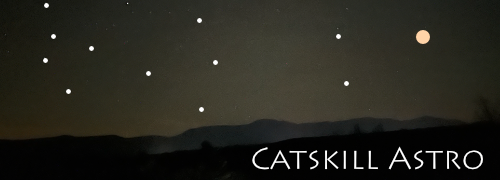Arp’s Peculiar Galaxies
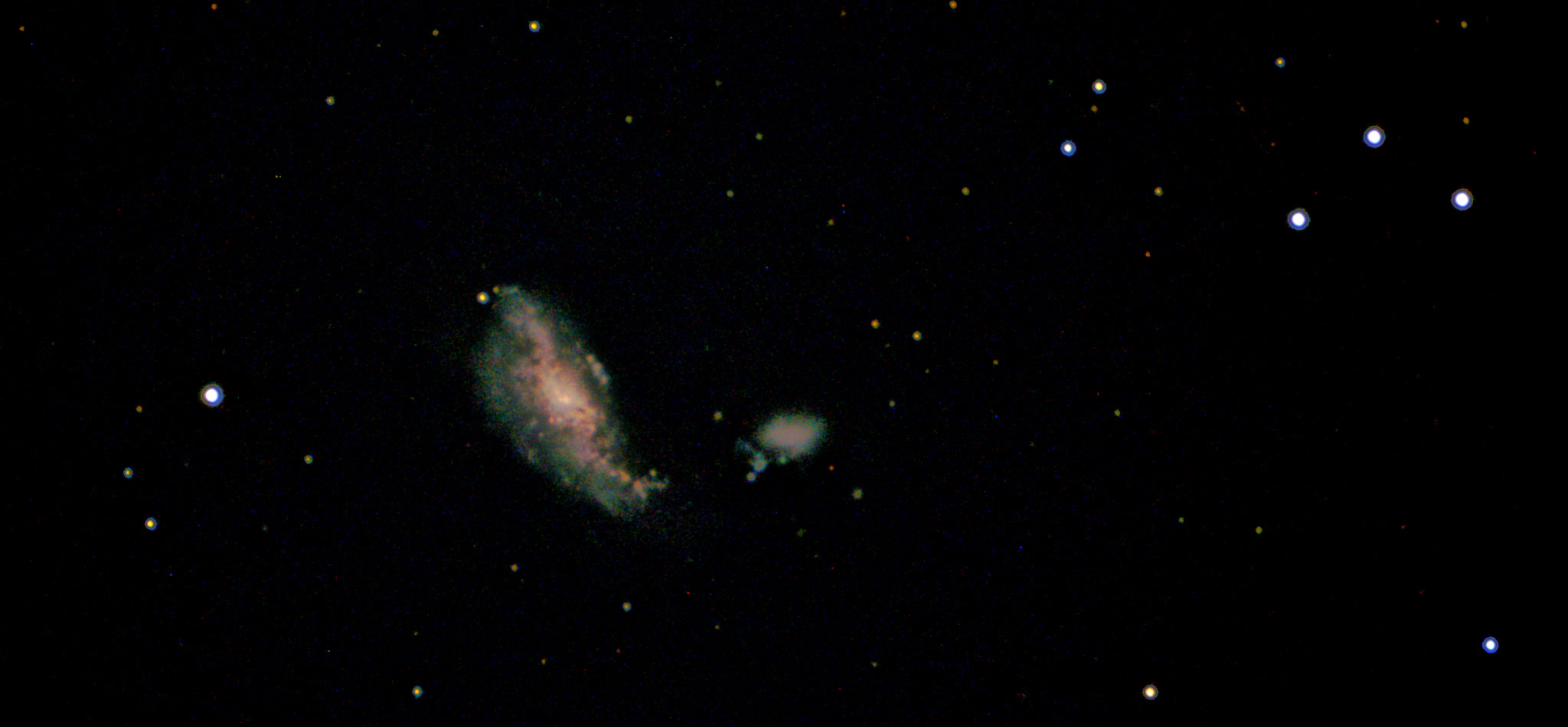
Page 9 of 16
Arp observations 81-90 of 155 total to date.
| Thumbnail | Title/link | Arp Category | Date Observed | Observer Description |
|---|---|---|---|---|
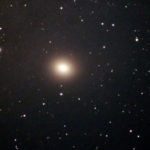 |
Arp 168 / M32 | Galaxies with diffuse counter-tails | 2024-02-20 20:00:00 | Messier recorded this object on August 3, 1764, the same date as M31, and attributed discovery to Guillaume-Joseph-Hyacinthe-Jean-Baptiste Le Gentil de la Galazière in 1749. <--> Note: this is the first of 11 Messier Galaxies that Halton Arp selected for his Atlas of Peculiar Galaxies. I developed this description as part of my qualifying for the AL Arp Observing award. This is a very famous galaxy, mostly imaged with its dominant partner, M31. It is extremely bright. I had fun with this, as I've never understood why Arp labelled it "peculiar", and after this "deep dive", I'm still skeptical. The recorded remarks on Arp 168 read as follows: "Faint diffuse plume curved away from M 31 disk." To be clear, M32 looks like a dwarf elliptical galaxy, which might qualify as peculiar by itself. But Arp's category here is defined by "diffuse counter-tails". As I understand it a counter-tail is an asymmetrical dust plume, today understood to be the result of a merger or impending merger. So, to test the "remarks" clarification, I needed to figure out what direction is Andromeda. So I converted my observation to an inverted image, and overlaid it on a personal capture of Andromeda (image 2). I then drew a line from the Center of M32 to M31 on top of my overlay, and cropped out the relevant bits (image 3). Note I left the overlay semi-transparent so you can judge the accuracy of the overlay. Then I took that overlay and placed it back on my original M32 inverted capture... placing an arrow on top of the line indicating towards M31's center (Image 4). -- At this point I removed the overlay to see my inverted capture, knowing the direction to Andromeda (Image 5). Do I think there is a longer plume due south, away from Andromeda? No. Arguably there is an extended plume SW (to lower left corner), but does that count? And is it enough to qualify M32 as peculiar? Just in case there is something about Arp's own capture, I overlaid it on this (image 6). Does it confirm a due south asymmetry? Not to my eye, and the posible SW asymmetry is not confirmed either. So, I continue to be skeptical of this one. |
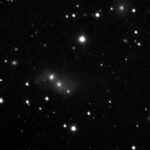 |
Arp 169 / NGC 7236-7237 | Galaxies with diffuse counter-tails | 2024-10-27 21:24:00 | Arp's remarks describe "Faint diffuse plumes coming away from two galaxies". Arp 169 consists of three relatively bright galaxies, lined up, all sharing a diffuse plume and presumably merging: lenticular galaxy NGC 7236, an eliptical galaxy NGC 7237, and a small elliptical: NGC 7237C. 7236's plume is extended to the Northeast, terminating at what appears to be a tiny dwarf galaxy. while 7237's even fainter plume appears extend to another tiny galaxy to the SW. |
 |
Arp 170 / NGC 7578 | Galaxies with diffuse counter-tails | 2024-11-03 22:17:00 | At the heart of Arp 170 is a merged, curved, diffuse envelope of what (from the shape) are at least two elliptical galaxies. However, a total of 5 or 6 possible galactic nucleii track the same curve as the envelope. Are they all galactic cores, or are some asterisms? I can't tell and even the Palomar image doesn't disambiguate it much. In the inverted image there is a triangular shaped counter-tail extending NNE which circumscribes a trapezoidal pattern of 4 likely, tiny galaxies or galaxy-fragments. There's just a hint in my capture that the plume continues to the medium sized spiral galaxy, seen edge-on, in the SE corner of the image. A smaller, roughly triangular counter-tail extends SSW from the last two bright object in the main curve. They extend towards another "spec" which could well be another tiny galaxy. |
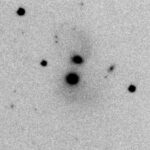 |
Arp 172 / IC 1178 & 1181 | Galaxies with diffuse counter-tails | 2025-07-15 23:50:00 | We're reaching the end of "galaxy season" and essentially all of the Arp galaxies are already past the meridian when it's dark enough to capture them. So I had no particular reason to capture Arp 172 except it was higher in the sky than most. This observation was cut short by clouds. It was also notable as the first time I'd used my Apollo-M camera without an IR/cut filter. I think it helped: I thought the capture was remarkably fast given the conditions. |
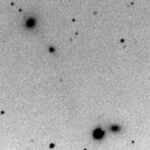 |
Arp 175 / IC 3481 & 3483 | Galaxies with narrow counter-tails | 2025-07-15 22:40:00 | At the root of the controversy is whether a tidal connection exists between IC 3481 and 3483. In his observing notes, Arp says the connection goes only "two-thirds of the way". But later images with different telescopes and emulsions made it appear that the connection is complete, and my observation could certainly be interpreted that way (though I wouldn't suggest it's definitive). Most Arp fans thought the connection existed, but then spectroscopic analysis gave 3483 a much lower redshift suggesting it was much closer. Arp argued that redshift measurements were not definitive, and if what you could plainly see was in conflict with theory, believe your eyes. Arp ultimately ultimately developed his theory of "intrinsic redshift" which made him a pariah within the Palomar community... It was one thing to point out peculiar galaxies: it made some Palomar astronomers uncomfortable, but others -- in particular Zwicky -- were strong supporters. However, this disagreement placed Arp in direct opposition to a central principle of Hubble's cosmology -- that redshift was a reliable measure of relative distance due to the expansion of the universe. Arp ultimately lost his observing privileges as a result. |
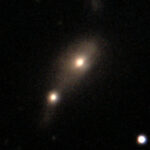 |
Arp 176 / NGC 4933 | Galaxies with narrow counter-tails | 2024-04-16 23:55:00 | This is a tiny cluster of 3 galaxies: NGC 4933 A/B/C. B is the tail galaxy which appears to be a small elliptical galaxy.. A is the middle, larger, spiral galaxy. C is the dim triangular nub ENE of A. The two brighter galaxies are Magnitude 13, and clearly interacting. C is magnitude 18.5 and does not seem to be interacting with the others. Arp remarks that "Companion galaxy very condensed." Assuming A is an elliptical galaxy, I interpret the remark as applying to the narrowness of the plume as it extends past the A's core, which accounts for the "narrow counter-tail". |
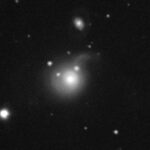 |
Arp 178 / NGC 5614, 5615, and 5613 | Galaxies with narrow counter-tails | 2025-07-18 22:44:00 | This is a truly enigmatic Arp object. At first glance it appears to be two galaxies interacting: NGC 5614 (the large galaxy) and NGC 5613 (the medium sized galaxy above it). Unfortunately, the giant plume (which is the predominant "peculiar" feature" doesn't make any sense in that context. It starts to make sense when you realize that the spot on the rim of 5614, close to the right hand edge at the base of the plume, is a dwarf spiral in its own right, NGC 5615. Then, especially after some enhancement, my image reveals some structure: a brighter tidal tail the width of NGC 5615 within the larger, much more diffuse plume that appears nearly structureless. In the first instance, it seems like this was formed by detritus left behind when 5615 was ripped out of a likely orbit (R to L). |
 |
Arp 181 / NGC 3215-3212 | Galaxies with narrow filaments | 2024-12-25 21:08:00 | We focused on illustrating the key feature that Arp called out: the "narrow filaments" or tidal tails emanating from NGC 3212. He remarked on the "long faint filament extend[ing] westward from south arm". This tests the limits of EAA techniques. While the galaxies themselves are reasonably bright at mag. 10.3 for NGC 3215, and 11.2 for 3212, the surface brightness of the long filament is MUCH dimmer. Note it's barely visible in Arp's plate, and this is one of the few faint details I was not able make readily visible in an inverted version. This despite 56m integration using a mono camera, which is normally more than adequate. While barely visible in the "as captured" EAA positive-image, visibility was enhanced using stretching and sharpening. The "annotated" image came from a 2013 paper in the Monthly Notices of the RAA. This notice, based principally on radio observations, concludes that the interaction has shifted an estimated 90% of the H1 mass outside the optical discs of the two galaxies. The interaction has triggered a burst of star formation activity in two "Tidal Dwarf Galaxies" which peak close to the end of the long filament which Arp called out, labelled TDG and SDSS, respectively. TDG is close to the end of the optical filament but not visible in optical wavelengths; SDSS corresponds to the middle smudge cut off by the western (bottom) border of the comparison images. It is fully visible in the "featured image" reproduced next to the table on wide screen devices. |
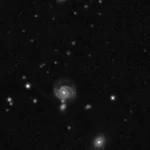 |
Arp 182 / NGC 7674 and 7675 / Hickson 96 | Galaxies with narrow filaments | 2024-11-03 23:08:00 | Arp 182 displays two faint filaments extending from what otherwise appears to be an intact spiral galaxy (NGC 7674) with a very close companion, and a second spiral much further away (NGC 7675) but likely gravitationally bound to it. Arp calls out the first filament in his remarks: "Long straight, very faint filament like bow wave from comp[anion]." If you imagine that the companion galaxy is a motorboat headed NW (up, left) to pass 7674 on its starboard bow, the "bow wave" leaves a triangular wake behind it. This is an extremely subtle, progressively widening, triangular filament. I believe it's more clear when I render Arp's plate as a positive [image 2 in gallery]. You see both Arp renderings in comparison to my positive image, which, frankly, does not show it. However, gallery image 3 is a negative (invert) of my capture, which does, particularly the southern side of the wake which appears to connect to NGC 7475 (and likely evidence of gravitational interaction). . Much more obvious in my inverted rendering is a semi-circular filament extending NE from 7674 (to the left and up), likely an extension of its bottom, spiral arm. |
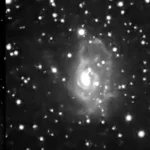 |
Arp 184 / NGC 1961 | Galaxies with narrow filaments | 2024-02-29 00:00:59 | This was an enjoyable, early capture, and after 40m of integration I shut things down thinking I'd done a great job. However, I hadn't focused on the peculiarity of this galaxy, which was, "Galaxies with narrow filaments". Turns out I had been fooled by the bright galactic center and disk, not recognizing that the filaments were MUCH less bright. My initial attempt with the color image was pretty poor. After using a mono camera starting in late October of 2024, I gained experience in post-processing mono images to bring out faint filaments. So on Election Day (November 5) I decided to convert this image to mono and try the same techniques. They turned out pretty well: the filaments are clearly visible. Luckily, these are the filaments that Arp calls out in the remarks: "Two long straight arms or filaments tangent to NE side of galaxy." Whew! |
